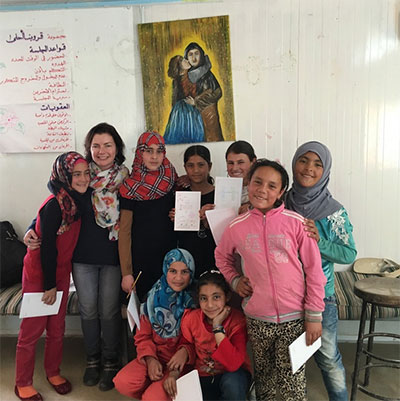 Recently, Karen, Fisher, UW Professor, visited the Library to share insights into her work with refugees. Below is a blog post by library employee, Carlisle Winifred Huntington.
Recently, Karen, Fisher, UW Professor, visited the Library to share insights into her work with refugees. Below is a blog post by library employee, Carlisle Winifred Huntington.
Creating Futures through Magical Devices and Library Caravans: Participatory Design with Syrian Youth at Za’atari Refugee Camp. http://syria.ischool.uw.edu/
I had the immense pleasure of listening in on Karen Fisher’s illuminating lecture about her work with Syrian youth at the Za’atari refugee camp in Jordan, hosted by the Collins Memorial Library. Karen E. Fisher is a professor at the Information School, as well as an adjunct professor of Communications at University of Washington. She has devoted her life to Humanitarian research and is especially passionate about developing ways in which HCI-industry-NGO collaborations can improve lives and build futures, starting with the young people at Za’atari.
Karen began her lecture by stating that the world is facing its worst refugee crisis since WWII. As of 2016, sixty five million refugees have been driven from their homes by war. Only one million of which are heading for Europe. In fact, 83% of all refugees will stay close to the centers of conflict, like those at Za’atari. The six years of war in Syria has brought forth 4.7 million new refugees and the numbers grow day by day. Za’atari is the second largest camp in the world, with a population of eighty three thousand people, most under the age of twenty five. In fact those most affected by the war and displacement are children and the elderly. Many young women are unable to attend attending school and getting an education, because once a wife, girls are forbidden to go to school due to household responsibilities. This kind of “information poverty”, as Karen called it, is rampant in the Za’atari camp. Although refugees are issued cellular devices, they are forbidden from accessing the Internet by the Jordanian government, as it could pose a security risk to the camp, as well as the surrounding area. As a result, many people in the camp are completely in the dark as to the goings on of life back home in Syria. Fisher describes how most refugees are desperate to know what life is like back home, where their family is, or how their property in Syria is fairing, if it is even still standing at all.
This why many refugees at Za’atari will treasure broken I-phones or tablets. Though the screen may be cracked or it may no longer have any cellular capabilities, the photos and the memories on the phones are priceless. One women in particular treasured a broken phone because it contained the only photo left of her dead son. The photo itself was a picture of her son’s body, and the phone was passed around the camp, searching for someone to identify him, until it finally reached his mother.
Despite the many grim realities these people have to face, there is still a never ending effort to keep hope alive in whatever way they can. Karen went on to describe one of the most impactful aspects of living at Za’atari camp was how nothing was ever wasted. Even the old tents were ripped apart and used as canvas to paint on. Artistic expression is a popular therapeutic tool for many of the refugees. Colorful murals and painted caravans can be found all over the camp, even the insides of people’s caravans are painted, often to resemble a lush green forest, creating an oasis in the harsh Jordan dessert. Being surrounded by color and beauty has been an immense comfort for the people living at Za’atari. Hope can also be found among the Syrian youth, whose imagination and creativity carries them through these difficult times. In one survey, Karen asked children to draw pictures of inventions they would want to create in order to make life easier at the camp. One little girl thought of magic glasses that could tell you what was wrong with a sick person and how to cure them, just by looking at them. Another thought of a robot to help the elderly. But one that struck Karen the most, was a depiction of two robots especially designed to create peace.
And therein lies the underlying desire that drives all refugees at Za’atari forward, the hope for peace. Despite all they have witnessed, all they have overcome, the people at Za’atari believe in peace, and believe that it is possible. And one way to help make that dream a reality is with the development of technology that allows all at Za’atari, though especially the youth, equal access to information and education. The development of libraries and other centers for learning at the refugee camp will be an enormous advancement in the lives of the young people affected by this global crisis. Because with knowledge, hopes and dreams can turn into tangible realities.
Note: The Collins Library staff with the assistance of community members and the University Bookstore collected art supplies, Karen Fisher took these supplies with her on her most recent trip to the Camp.
